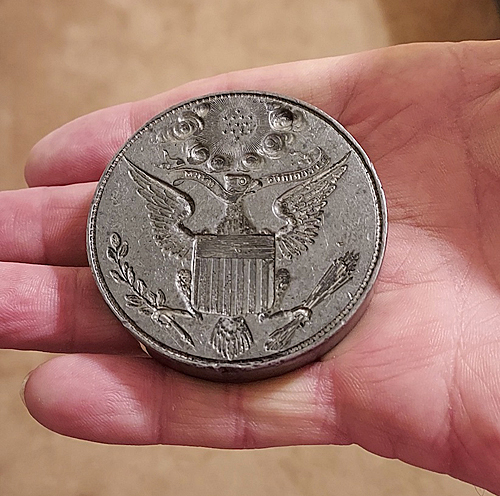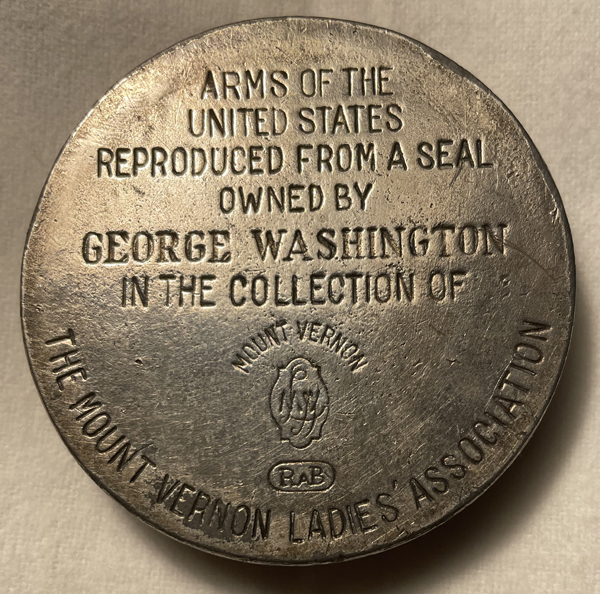

|
Main Pages Design Process
Latin Mottoes
Symbols (front)
Symbols (back)
Great Seals
Themes
Related
|
The Mystery of George Washington
|
|
The following is from "The Seal of the President," Chapter 16 of
One day in early June 1894 a young man named Palemon Howard Dorsett presented himself at the Department of State and sought out Gaillard Hunt, who recently wrote a brochure titled The Seal of the United States. Dorsett showed Hunt a metal die incised with the arms of the United States that had been handed down in his family from a kinsman who had received it from a nephew of George Washington. Hunt examined the die and noted: "This seal is almost identical with the first seal, cut in 1782... It is cut on the same metal and no other seal is as much like the first seal... It is fair to presume that this seal is contemporaneous with the seal of 1782." (shown above). Hunt took no further interest in the matter. Forty-two years later in 1936, Dorsett wrote a letter to Secretary of State Cordell Hull, saying: "This Seal has been in the possession of the Dorsett family for more than a century. From earliest childhood I recall innumerable occasions when the Seal was under discussion, that my parents invariably stated that it was given to Jim Starr, a nephew of Grandmother Winchester, on my mother's side, by a nephew of General Washington, and that the two young men were very warm personal friends." The State Department's Historical Adviser Hunter Miller took a look at Mr. Dorsett's die. Examination showed it to be 2 5/16 inches in diameter and 3/8 of an inch thick, its back a solid flat surface, with no handle or place for attaching one and no evident provision for fixing it in a press. On April 17, 1936, the Division of Chemistry of the Bureau of Standards analyzed a "whisker" of metal taken from the die and reported it to be of "copper and tin" – that is, bronze. Comparison of an impression from the Dorsett seal with one from the Great Seal die of 1782 reveals some striking resemblances.
The Dorsett die differs from the 1782 die in one conspicuous way. The olive branch and bundle of arrows are transposed, so the eagle faces the arrows in its right talon. In this respect it departs from the specifications of the resolution of Congress of June 20, 1782. It can be said with certainty that at no time was that seal ever used as the Great Seal of the United States. In fact, no impression from the Dorsett seal die has been found anywhere. Searches of printed sources of various kinds, including legislative records, have failed to reveal any further information. Lending credence to the Dorsett story is "An Inventory of Articles at Mount Vernon" prepared shortly after Washington's death in 1799. It includes "In the Iron Chest... 1 Brass engraving of the Arms of the U. States." A record of items sold at Mount Vernon on July 21 & 22, 1802 includes what was described as: "plates arms U.S." Perhaps this refers to that "Brass engraving of the Arms of the U. States." The word "plates," however, is puzzling – both the word itself and its use in the plural. The Dorsett Seal could conceivably be called a plate. Furthermore, the arms of the United States have a reverse, which engraved on another bronze disk would have been reason for use of the plural. Perhaps the Dorsett seal was one of a pair, the reverse of which is now missing.
How and why did the Dorsett seal die come into existence, and what purpose was it intended to serve? Lacking facts, one must speculate as to the answers. The transposing of the olive branch and the arrows was certainly intentional. It constituted a "difference" in the heraldic sense of the term that distinguished this seal unmistakably from the Great Seal without obliterating evidence of close relationship to it.
This leaves, as the only remaining possibility, the conclusion that Washington received the die as a gift. Such a gift could have come either from an engraver who had cut the die himself or from someone else, who had employed an engraver to cut it. In 1941 Dorsett placed the seal on loan at Mount Vernon. After his death in 1943, his sister changed the loan to an unrestricted gift to the Mount Vernon Ladies' Association. In the absence of further information, the Dorsett seal may be counted as either the immediate predecessor or the earliest example of the seal of the President of the United States. |

Larry McGarrah (August 2021)
Larry is an Army veteran and retired Biomed Tech researcher whose hobby is looking for treasures at swap meets, antique malls, and yard sales. Purchased at a swap meet in Arizona, this die is in very good condition.

Roger Goldstein (June 2022)
This die was a gift to Roger when he was a child. Its reverse side motivated him to reach out to the Mount Vernon Ladies' Association, who responded:
|
As you suspected, this is a souvenir that was issued by the Mount Vernon Ladies' Association. It is a replica of the "Dorsett die," which features a design very similar to the Great Seal of the United States... This is likely the "1 Brass engraving of the Arms of the U. States" that is listed in George Washington's study on the inventory of Mount Vernon taken after his death in 1799. The reproductions of the seal were produced through a partnership between the MVLA and silversmiths Reed and Barton in the early 1980s. The MVLA initially planned to order 1,000 of them, but the exact number ultimately produced is unknown. These items were sold in the gift shop and given as gifts to donors. One was also given to President and Mrs. Reagan when they visited Mount Vernon in 1982. The partnership with Reed and Barton had ended by 1983. – Jessie MacLeod, Associate Curator,
At the top of this page is the Dorsett Die image Jessie sent. |